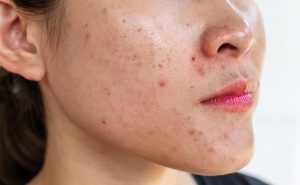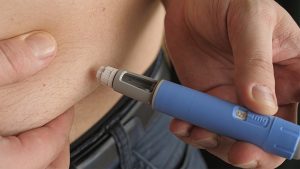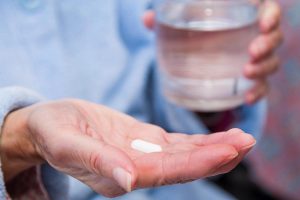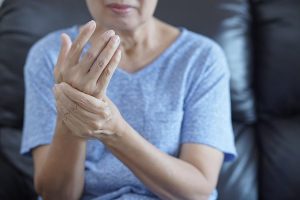(HealthDay News) — A chemical peel can reduce signs of aging and treat a variety of skin conditions, says the American Academy of Dermatology. Acne, discoloration, freckles and sun-damaged skin are some of the many conditions commonly treated with a peel. After treatment, patients often see smoother skin, a brighter complexion, a more-even skin tone and fewer wrinkles. However, before considering treatment, it is important to remember that chemical peels are considered cosmetic treatments, so insurance may not cover the cost.
All Health/Fitness:
Does Diet Affect a Child’s ADHD?

Parents of kids with attention-deficit hyperactivity disorder (ADHD) may change their child’s diet in the hope it might ease the disorder’s symptoms. But a new study suggests it might not be worth the effort. The researchers found that while kids with ADHD are more likely to have unhealthy diets, their poor diets weren’t at the root of their ADHD symptoms. “In contrast to what may be expected, we observed that a poor diet does not predict the level of ADHD symptoms in children, either diagnosed or not. So, based on our study, dietary changes may not prevent or reduce ADHD symptoms,” said study author Trudy Voortman. She’s an assistant professor of nutritional epidemiology at Erasmus University Medical Center in Rotterdam, the Netherlands. Diet has long been suspected to play a role in ADHD. People have tried avoiding certain nutrients or adding supplements to improve symptoms, according to background information in the study. But the researchers wanted to know if the quality of a child’s overall diet might make a difference in their symptoms. They studied nearly 3,700 children with ADHD from Rotterdam at ages 6, 8 and 10. The researchers figured out each child’s dietary quality score based on the foods they reported eating when they were 8. Voortman said that children with ADHD had higher than recommended amounts of sugar-sweetened beverages and processed meats.… read on >
Nearly 700,000 Infant Rocking Sleepers Recalled Due to Infant Deaths

The Kids II company is recalling nearly 700,000 of its Rocking Sleepers for infants, after reports of babies dying have been linked to the products’ use. In an announcement posted Friday on the U.S. Consumer Product Safety Commission’s (CPSC) website, the agency says the recall follows deaths occurring “after the infants rolled from their back to their stomach while unrestrained, or under other circumstances.” The recall comes just two weeks after the American Academy of Pediatrics (AAP) urged a recall of another brand of sleeper, Fisher Price’s popular Rock n’ Play sleeper. That inclined sleeper has been associated with 32 sleep-related infant deaths, according to a new Consumer Reports analysis. The CPSC and Fisher-Price issued a warning about the Rock ‘n Play Sleeper on April 5, but that’s not enough to protect infants, according to the AAP. “This product is deadly and should be recalled immediately,” AAP President Dr. Kyle Yasuda said in a news release from the group. The new recall involves 694,000 Kids II sleepers, which the CPSC says have been linked to five infant deaths since the products began being sold in 2012. The Kids II sleepers were sold at “major retailers nationwide, including Walmart, Target and Toys “R” Us and online from March 2012 through April 26, 2019 for approximately $40-$80,” the CPSC said. “Consumers should immediately stop using the product… read on >
Parents, Protect Your Kids as Measles Outbreaks Spread

As measles outbreaks spread across the United States, there are a number of things parents need to know, a leading pediatricians’ group says. The most important is to make sure your children are fully protected against the disease, which can be deadly, the American Academy of Pediatrics (AAP) advised. Only the measles vaccine can do that. The United States is in the middle of a record year for measles cases. Last week, the U.S. Centers for Disease Control and Prevention reported the number of measles cases has reached 695 — the highest level since the disease was declared eliminated in 2000. Outbreaks are occurring across the country, with one of the largest ones playing out in New York City, where 61 new cases were reported last week. Los Angeles County has also declared a measles outbreak, with quarantine orders issued to more than 200 students and employees at the University of California, Los Angeles, and California State-Los Angeles because they may have been exposed to the highly contagious disease. The ongoing outbreaks have occurred as some parents refuse or delay immunizing their children out of unfounded concern about safety of the measles vaccine. The result is more unvaccinated children, teens and adults. Not only are unvaccinated children more susceptible to getting measles, they can spread it to others. Most of the recent flare-ups in the… read on >
Snoring Not Just a Male Problem

New research shows that snoring is not the sole domain of men. “We found that although no difference in snoring intensity was found between genders, women tend to underreport the fact that they snore and to underestimate the loudness of their snoring,” said lead investigator Dr. Nimrod Maimon. He is head of internal medicine at Soroka University Medical Center in Be’er Sheva, Israel. “Women reported snoring less often and described it as milder,” Maimon said in a news release from the American Academy of Sleep Medicine. The study included more than 1,900 people, average age 49, who were referred to a sleep disorders center. Snoring was found in 88% of the women, but only 72% reported that they snore. Both rates were about 93% in men in the study group. Among people who snored, the average maximum loudness was 50 decibels among women and 51.7 decibels among men. While 49% of the women had severe/very severe snoring, only 40% rated their snoring at this level, the researchers found. The study authors noted that there is a social stigma associated with snoring among women, so women may not be truthful when asked about snoring. More troubling, this may contribute to the underdiagnosis of obstructive sleep apnea in women. Snoring is a common warning sign for obstructive sleep apnea, in which the upper airway repeatedly collapses during… read on >
How Much Does Your Kid Weigh? Chances Are, You’re Underestimating

Parents and doctors often overlook how overweight kids are, which could leave youngsters at increased risk for health problems linked to excess weight, British researchers say. They reviewed 87 studies that included nearly 25,000 children, age 19 and younger, and their parents. The researchers found that 55% of parents underestimated how much excess weight their children were carrying, and 34% of kids underestimated their own weight. Even health care providers sometimes missed the mark. Parents of younger kids were less likely to recognize a weight problem, and were less accurate at gauging boys’ weight than girls’. Overweight parents and those with less education were more likely to underestimate their child’s weight problem. In some of the studies reviewed, parents often described their children as big-boned, thick or solid, and they demonstrated a strong desire to avoid labeling their child obese. The research review is to be presented Saturday at the European Congress on Obesity (ECO) in Glasgow, Scotland. Studies presented at meetings are typically considered preliminary until published in a peer-reviewed journal. This research dovetails with a 10-fold increase over four decades in the number of obese children and teens worldwide — from 5 million girls in 1975 to 50 million in 2016, and from 6 million to 74 million boys. “Despite attempts to raise public awareness of the obesity problem, our findings indicate that… read on >
Breast Milk Has Biggest Benefit for Preemies’ Brains: Study

Another reason breast is best: Breast milk boosts levels of chemicals crucial for brain growth and development in premature babies with a very low birth weight, a new study reveals. “Our previous research established that vulnerable preterm infants who are fed breast milk early in life have improved brain growth and neurodevelopmental outcomes,” said Catherine Limperopoulos, director of MRI research of the developing brain at Children’s National Health System in Washington, D.C. However, she added, “It was unclear what makes breastfeeding so beneficial for newborns’ developing brains.” For the new study, her team used “proton magnetic resonance spectroscopy” to solve the mystery. The non-invasive imaging reveals the chemical makeup of specific brain structures, enabling researchers to measure metabolites essential for growth. With this technology, the researchers examined the brains of very low birth weight babies (under 3.3 pounds). The infants were born after no more than 32 weeks of pregnancy. The team focused on the right frontal white matter and the cerebellum, a brain region that’s involved in balance, muscle coordination and supports high-order mental functions. Compared to formula-fed babies, those fed breast milk had significantly higher levels of inositol in the cerebral white matter, and significantly higher creatine levels. Study lead author Katherine Ottolini explained that “key metabolite levels ramp up during the times babies’ brains experience exponential growth.” The percentage of days infants… read on >
Is Peanut Allergy ‘Immunotherapy’ Causing More Harm Than Good?

The idea behind immunotherapy for peanut allergy is appealing in its simplicity: Ask a patient to eat tiny amounts of peanut every day, and over time their immune system will become desensitized to it. Unfortunately, this cure might be doing more harm than the allergy itself, a new evidence review suggests. People who undergo immunotherapy for their peanut allergies wind up with a large increase in life-threatening anaphylaxis and other allergic reactions, compared to others who either avoid peanuts or are in a placebo group, researchers concluded. Peanut immunotherapy triples a patient’s risk of anaphylaxis and doubles the chances they’ll need to use epinephrine to counter a severe allergic reaction. “We found that patients on immunotherapy, their quality of life wasn’t any better,” said lead researcher Dr. Derek Chu, a fellow in clinical immunology at McMaster University in Ontario, Canada. “Outside of the clinic, they actually end up having more allergic reactions over time.” Chu’s team discovered this troubling fact after pooling results of 12 peanut immunotherapy trials involving more than 1,000 patients. “If you looked at each study one by one, you might not see that,” Chu said. “When you combine them all, and you analyze all 1,000 patients in unison, then you can actually see it.” Food allergies affect more than 6 million people, including as many as 8% of children and 3%… read on >
Breast Milk Has Biggest Benefit for Preemies’ Brains: Study

Another reason breast is best: Breast milk boosts levels of chemicals crucial for brain growth and development in premature babies with a very low birth weight, a new study reveals. “Our previous research established that vulnerable preterm infants who are fed breast milk early in life have improved brain growth and neurodevelopmental outcomes,” said Catherine Limperopoulos, director of MRI research of the developing brain at Children’s National Health System in Washington, D.C. However, she added, “It was unclear what makes breastfeeding so beneficial for newborns’ developing brains.” For the new study, her team used “proton magnetic resonance spectroscopy” to solve the mystery. The non-invasive imaging reveals the chemical makeup of specific brain structures, enabling researchers to measure metabolites essential for growth. With this technology, the researchers examined the brains of very low birth weight babies (under 3.3 pounds). The infants were born after no more than 32 weeks of pregnancy. The team focused on the right frontal white matter and the cerebellum, a brain region that’s involved in balance, muscle coordination and supports high-order mental functions. Compared to formula-fed babies, those fed breast milk had significantly higher levels of inositol in the cerebral white matter, and significantly higher creatine levels. Study lead author Katherine Ottolini explained that “key metabolite levels ramp up during the times babies’ brains experience exponential growth.” The percentage of days infants… read on >
For Obese People, Commuting by Car Can Be a Killer: Study

Being obese and commuting by car can be a deadly mix, a new study warns. Researchers analyzed data on more than 163,000 adults, aged 37 to 73, in the United Kingdom. The participants were followed for an average of five years. Compared to people of normal weight who walked or cycled to work (active commuters), those who were obese and commuted by car had a 32% higher risk of early death from any cause; twice the risk of dying from heart disease; and a 59% higher risk for non-fatal heart disease. Obesity was defined by the researchers as having a body mass index (BMI) of more than 30. BMI is a measure of body fat based on height and weight. As an example, a person who is 5 feet, 9 inches tall weighing 204 pounds has a BMI of just over 30. The study also found that overall risk of early death among obese people who were active commuters was similar to that for active commuters whose weight was normal. That suggests cycling or walking to work could reduce the harmful effects of obesity. However, the risk of heart disease was still 82% higher for obese active commuters than for normal-weight active commuters, researchers said. “Our findings, if causal, suggest that people with overweight or obesity could potentially decrease the risk of premature mortality if… read on >

























-300x200.jpg)



